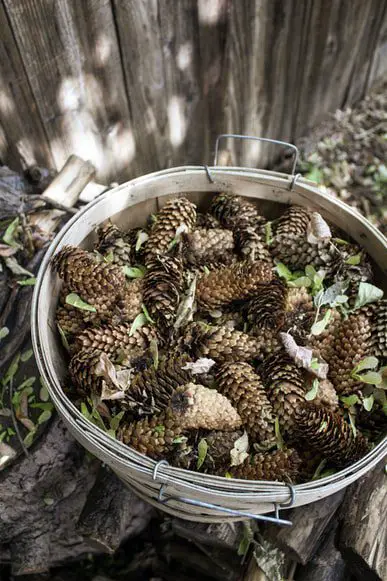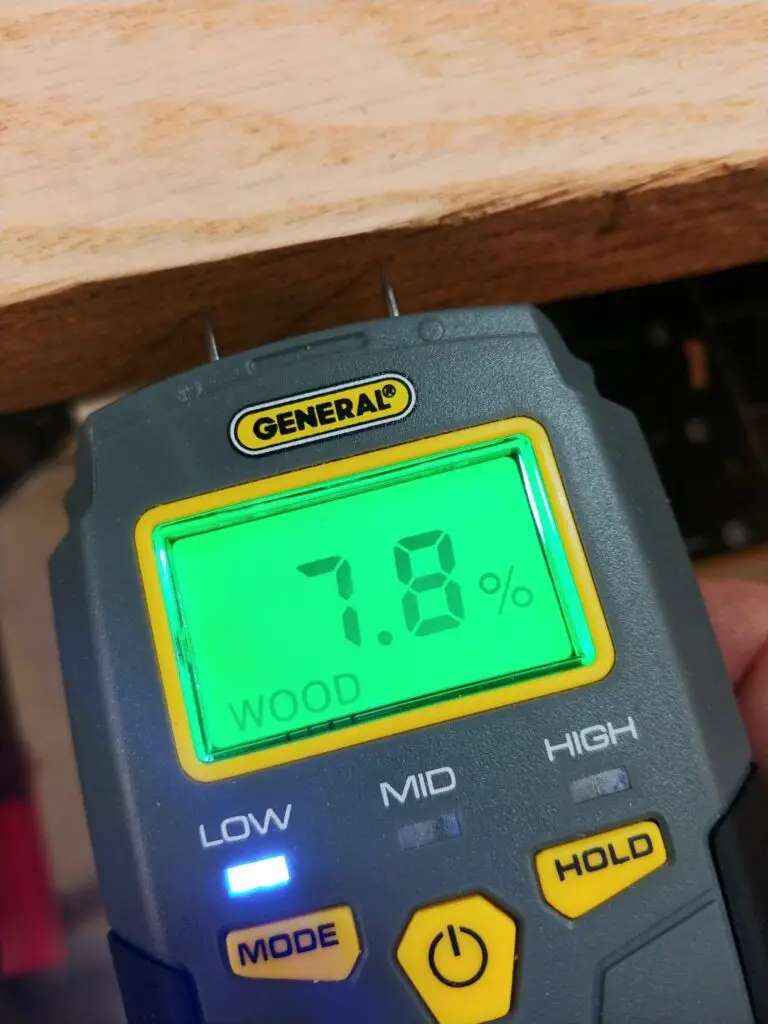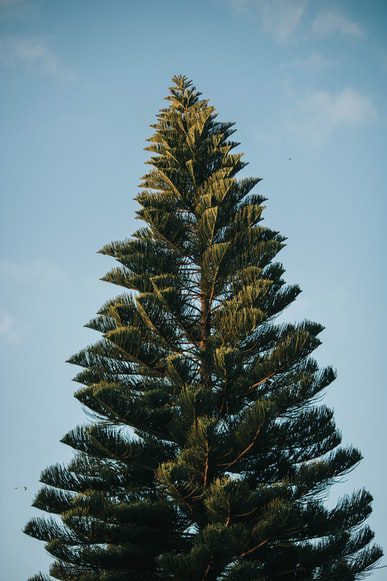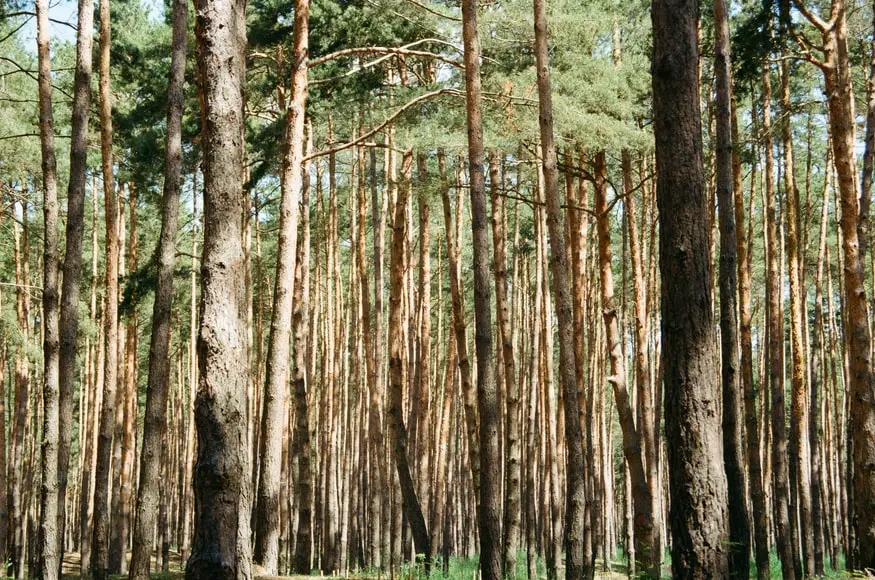Pine firewood is ideally used outdoors and is great for kindling because of its high resin content.
However, pine firewood is not ideal to use indoors because of its high creosote build-up, high smoke production, and lack of coals.
For kindling purposes, inside and out, pine shines. Specifically, fatwood, or the heartwood of pine trees, is prized for its use as kindling.
Pine is one of the most easily identifiable trees in North America and can be found in all different climates.
With it’s extremely distinct smell, its no wonder why pinewood is a popular outdoors firewood for bonfires, campers, and outdoorsmen.
Table of Contents
Summary
- BTU: 15.9 to 21.1 million per cord
- Weight: 2250 to 2610 Ib (seasoned cord)
- Sap Content: High
- Seasoning TIme: 6-8 months
- Smoke: Average to heavy
- Splitting Difficulty: Easy
- Smell: Pleasant
Pine is an evergreen tree and a softwood. Pine has needles that may dry and drop each season, but overall keep their green throughout the winter and do not shed.
Pine trees produce an incredible amount of sap, to the point of dripping sap (remember not to park under a pine tree!). Both male and female pine trees grow cones, but only the female cones contain seeds. Dried pine cones are an incredible fire starter, along with dried pine needles.

Heat Production
British Thermal Unit, or BTU, measures the heat produced from any source. You will also see this unit of measurement on air conditioners, space heaters, and gas firepits. Most varieties of pine produce 15.0 to 21.1 million BTUs.
Compared to other firewoods, pine produces a low amount of heat in BTUs. Of course, this changes based on species, but overall, pine firewood does not make as much heat as more popular choices of indoor firewood.
The southern yellow pine has the highest heat output at 21.1 million BTUs (source).
Remember that these numbers are for dry, seasoned pine wood with a moisture content of under 20%. Firewood that is burned while green will produce less heat because most of it is wasted, vaporizing the moisture of the wood.
Because pine is a softwood, the wood will burn fast, and the coals will not last long. While this may be bad for cooking over a fire or inside your stove, this may be great for camping purposes, where you want the fire to die out quickly at the end of the night.
Smoke Production
Pinewood burnt alone will smoke quite a bit.
Because of pinewood’s high resin content, it can be potentially dangerous to burn un-seasoned pine inside.
Seasoned pine is relatively light and will pop and crackle when burning, which is another reason to keep this firewood outside.
Seasoning Time
Pine firewood is similar to most firewood types in that it needs to season for six to twelve months.
Soft firewood takes less time to season as compared to hardwoods, like oak. Take this into consideration if you are looking for firewood to season quickly.
The longer you let your pinewood season for, the faster it will burn once in the fire. However, the shorter you let your pinewood season for, the smokier it will be.
Depending on the circumstances you are using your pine firewood for, you may want to adjust your seasoning length accordingly.
I personally recommend this General Tools Moisture Meter. It allows you to accurately gauge how wet your firewood is and whether it is sufficiently seasoned. Over time you can also see how quickly the moisture is dropping and how much longer you need to keep your firewood dropping until it is seasoned and ready to burn.
Press the sharp pins into the wood and you will quickly see the readout show the moisture ranging from 5% to 50%. It also has a Low/Mid/High indication depending on whether the wood is dry enough, so you don’t need to remember the actual values.

Burning Smell
Pine has a very distinct and pleasant smell to it. You will find pine scents in soaps, candles, and other household fragrances.
I know, for me, pine always reminds me of the holidays and celebrating the winter months.
While pine does have a wonderful smell, it is not recommended to smoke any food with pinewood. You should smoke meats and cheeses with hardwood.
If you would like to add a pine smell to your house, occasionally sprinkle some dried pine needles onto your already roaring fire. You can also mix dried pine needles and wax in a silicone mold. Once the wax has hardened, you can use these as a homemade firestarter.
Place some dried pine needles and rice into small homemade pillows to keep your dresser drawers smelling fresh.
The scent of pine also keeps away bugs and critters. Place some pine needles in your winter garden to keep out voles and pests.
Creosote Buildup
Creosote is a dark brown tar deposited from wood smoke that can build up on the insides of your chimney walls. It contains tiny unburned particles of wood and sap found in smoke. Creosote can be extremely dangerous because of how flammable creosote is and will easily start a chimney fire.
You’re looking at one of the highest producers in terms of pinewood and creosote.
Pinewood will cause large amounts of creosote buildup because of pine’s high sap content.
Even when pinewood is dry and seasoned, it will still create more creosote than other woods, such as oak or maple.
This is why pine is highly suggested to be used outdoors only or for kindling.

Splitting
Pine can be very easy to split but be prepared for a mess. Because of the sap, you’ll find your axe or machinery sticky, dirty, and hard to clean by the end of splitting pinewood.
As mentioned before, pinewood is fantastic kindling inside and out, so splitting your wood down to a kindling size may be ideal.
You can find Fatwood inside of dead pine stumps, so this is not something you can cut out of a felled tree.
Seasoning softwood trees take less time than hardwoods. Pinewood will typically only need a whole summer to a year to bring its moisture content lower than 20%.
Some species of pine may be more difficult to split because of the many knots some pine trees have. In these cases, use your splitter or maul and split from the root end. Halve the round so that the split goes between the knots. Then, split the haves in wedges from the root end to go through the knot.
Another excellent tip for splitting difficult pine is to wait until the temperature has dropped below 20℉ for a couple of days. The cold temperatures will make it easier for you to split your wood.
Different Types/Species
Pines are easily recognizable and are widespread throughout North America.
There are as many as 126 species of pine throughout the world, but only 49 species are native to North America.
Needles are found in bundles between 2-5 and attached by scales to the twig. Even when pine needles drop biannually, a healthy pine tree will maintain its evergreen appearance.
Evergreen trees like acidic, well drained soils and will often grow all together in large groups in forests. If you find yourself in an evergreen area and there are not many other plants on the ground, this is a called a forest desert.
The most common and valuable pines are
- Eastern White Pine
- Western White Pine
- Sugar Pine
- Red Pine
- Pitch Pine
- Jack Pine
- Longleaf Pine
- Shortleaf Pine
- Loblolly Pine
- Slash Pine
- Virginia Pine
- Lodgepole Pine
- Ponderosa Pine

Eastern White Pine (Pinus stroubus)
Eastern White Pine is one of the fastest-growing trees and can grow to the height of 230 ft – making it one of the tallest pines of the species. White pines produce long 6-inch cones. Needles are bluish-green, appear in small clusters and contain five needles per cluster.
Ponderosa Pine (Pinus ponderosa)
Ponderosa Pine is heavily used in the timber industry and is also called the Western Yellow Pine, Bull Pine, or Blackjack Pine. These pines can reach heights of 235 ft and have an orange-red bark with black margins.
Lodgepole Pine (Pinus contorta)
Found primarily on high altitudes on cold mountains or coastal areas, Lodgepole Pines will adapt to their environment and change the way of their growth. Some pines will grow as tall, slender trees, whereas others will grow more like a bush or shrub. The needles are dark green and glossy in the summer and bright yellow-green in the winter.
Comparison to Other Woods
Here, I’ve taken some of the most popular firewoods to burn indoors and compared them to our topic of today, pine firewood.
| Firewood | BTUs | Ease of Splitting | Coals | Overall Quality |
| Green Ash | 20.0 | Easy | Good | Excellent |
| Maple | 25.5 | Easy | Excellent | Excellent |
| Bur Oak | 26.2 | Easy | Good | Excellent |
| White Pine | 15.9 | Easy | Poor | Fair |
Pine trees, in comparison to other woods, is stiff but also resistant to shock, which is why many furniture pieces are made of pine. Pinewood will sell cheaper than other woods including oak and ash.
Frequently Asked Questions
Can I burn pine in my fire pit?
Absolutely, and a firepit is exactly where you should be burning pine. Because pine is smokier and creates lots of creosote buildup, and burns quickly, an outdoor fire pit is ideal for burning it.
What does pine firewood look like?
Pine is one of the easiest types of firewood to identify. Check out the end-grain, and you should be able to see sticky sap leaking out of the wood. If you pick up a piece of wood that is sticky, it’s most likely pine.
Is it safe to burn pine in a fireplace?
If you are mixing pine with other hardwoods or exclusively using pine as kindling, pine is safe to use in your fireplace. It is not recommended to use pine exclusively in a fireplace because of the creosote that builds up and its higher smoke production.
How can you tell between pine and hardwood firewood?
Looking at the wood grain will be your indicator if you are holding a softwood (like pine) or a hardwood. Hardwoods grow slowly over time and will end up with a thick, dense grain. Softwoods, on the other hand, will have a softer grain and feel (hence the name).
Is pine firewood good for camping?
Pine is excellent firewood to use for camping. Because pinewood burns so quickly, your fire will also die quickly at the end of the night, which is ideal for camping because you never want to leave a fire unattended.
Just remember to follow local ordinances for burning firewood while camping. In some areas of the country, you are not allowed to bring wood from outside the area (to avoid pests and invasive species). In places like these, you will need to purchase firewood from the camp itself, or in town. Make sure to take a ‘local bought’ tag with you if you buy in town.
Can you burn pine in a wood stove?
Much like burning pine in a fireplace, it is not recommended to burn pine in your wood stove exclusively due to the creosote build-up and smoking potential. Either mix your woods together or use pine as kindling only.
How much does pine cost to buy?
Because pine is not ideal for burning inside, it is actually relatively easy to find pinewood that is either being given away for free or at a meager cost. However, if you are looking to purchase a cord of pine firewood from a company that splits and seasons the wood for you, you’re looking at spending between $120-$180 per cord. Of course, these prices will vary depending on pinewood availability and season.
Final Thoughts
Pinewood has one great strength over other woods, in that it is incredible kindling. All parts of the pine tree are good for firestarting including the needles, pinecones, fatwood, and small sticks.
However, that’s pretty much where the benefits of pine end. It is clearly not recommended to burn pine indoors in your wood stove or fireplace. Keep pine outside in the firepit, and enjoy the classic campfire smell of burning pine.
